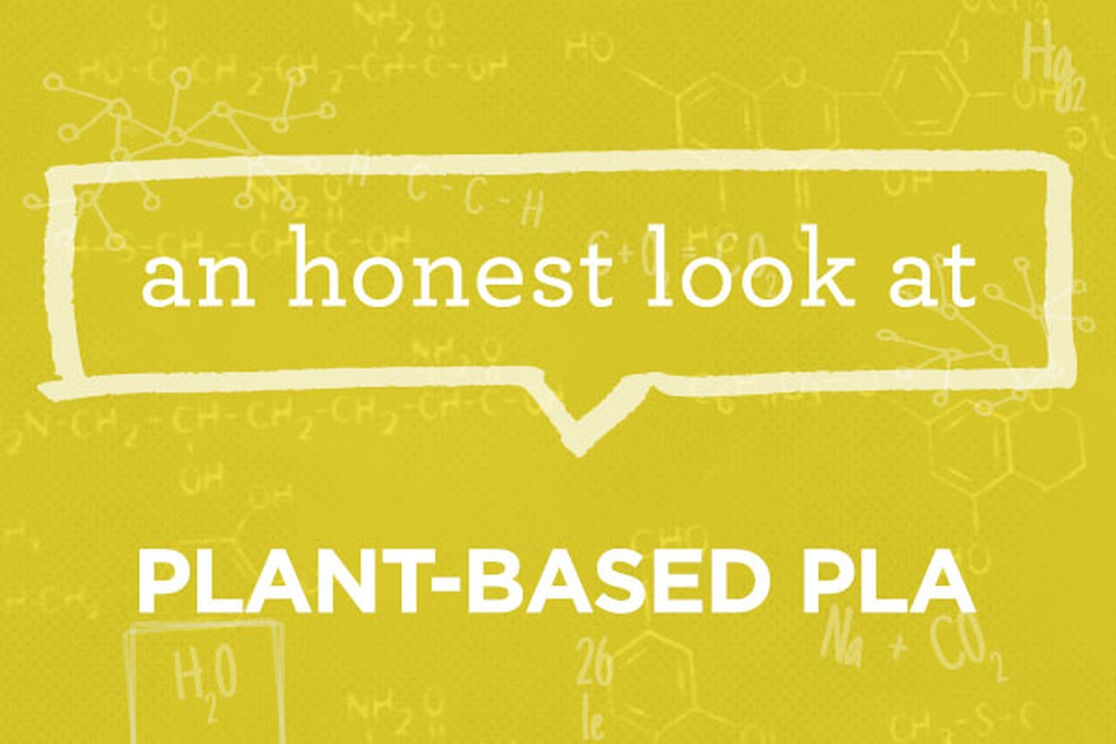This is part of our ongoing series to help consumers better understand chemicals, chemistry, and product formulations. We translate the science, bust the myths, and give you an honest assessment, so you can make informed choices for your family!
Ingredient:
Plant-based PLA (aka: ‘polylactide (PLA) biopolymer resin’)
What it is:
PLA is a plant-based plastic and ours is made from dextrose (sugar) derived from corn. It’s a pretty amazing feat of green chemistry, but it’s simple enough that you can easily replicate in your own kitchen using cornstarch, hot water, vinegar, and glycerin — how cool is that? At the commercial production level, it’s a little more complex. Here are the steps that transform plants into plastic:
- First, corn is steeped in sulphur dioxide (made from burning natural sulfur) and hot water to loosen the molecular bonds in the kernels.
- Next, the mixture is ground up in a giant blender and centrifuged (spun around very quickly) to separate the corn oil from the starch.
- Then, the dextrose is extracted from the starch through a process called hydrolysis. If you’re not familiar with hydrolysis, it’s a reaction involving the breaking of a bond in a molecule using water (picture dissolving salt into water).
- Next, the dextrose is fermented to form lactic acid.
- The lactic acid goes through a process called electrodialysis (the same process used to desalinate seawater), resulting in lactide.
- Finally, the lactide is treated with a catalyst (a substance that speeds up a chemical reaction, but is not consumed by the reaction), opening the molecules and linking them into long chains (aka ‘polymers’) consisting of tens of thousands of units linked together.
All plastics are made from these long chains of molecules, but in this case, the polymer is created from molecules from corn instead of molecules from petroleum.
What it does:
Just like many other plastics, PLA can be used in a wide variety of consumer products, including food serviceware, food packaging, electronics, gift cards, disposable wipes, clothing, and home textiles.
Why we use it:
We use it for the inner and outer layers of our premium, eco-friendly* diapers — made with naturally derived, plant-based & sustainable materials* — because it performs just as well as its conventional counterparts, but it’s far better for the planet. Not only does it come from a natural, renewable resource, but the production of our PLA uses 65% less fossil fuels and emits 80-90% less greenhouse gas compared to oil-based plastics. (This data is specific to the biopolymer we use, and NOT just any polylactide.) Also, this PLA has more end-of-life options than any traditional plastic — it can be cleanly incinerated, industrially composted, or even converted back into lactic acid to create more biopolymer. *Note: We do not recommend putting our diapers in your compost at home.
Why we’re featuring it today:
While our PLA is a huge improvement over traditional plastics, there are still a couple of issues that need addressing that customers have expressed concern about.
Using a Food Crop
Some people find it upsetting that we’re using a food crop to make plastic when hunger is such a huge global issue. It’s a very valid point and our supplier says they use such a small amount of the annual global corn crop, there’s little to no impact on food prices or supply.
Also, their process does not require corn per se; just a sugar source. In the future they’ll be sourcing the dextrose from more sustainable sources like cellulosic raw materials, agricultural wastes, and non-food plants.
GMOs (or Genetically Engineered Ingredients)
Our supplier sources corn from local farmers, which grow a mixture of both non-GMO (genetically engineered) and GM corn. Unfortunately, at this facility there's no method for processing non-GMO corn separately from GM corn, so it all gets mixed together. Fortunately, the corn is broken down and processed to such an extent that the molecular make up is completely transformed and none of the GMO attributes remain in the final product. It is free of any genetically-modified material and tested/certified by GeneScan Inc., which is recognized by both government and NGO's as the leading authority for testing food, feed, and raw materials.
Using GMOs is certainly not ideal and we're committed to avoiding them as much as possible in all of our products. In this case, the fact of the matter is that the market for this particular material is still budding and the sourcing isn't adequately accessible or reliable for large-scale production quite yet. We're definitely hoping with the growth of our company and the demand of our community, we can create change in the system! We'd gladly prefer to use non-GMO, organic, sustainable plant sources for everything! In the meantime, we felt plant-based (even GM) was preferable to petroleum-based. It's never an easy choice. (Read more about the Honest balancing act and long-term vision.) We admit it’s not perfect, but it’s a giant leap in the right direction. You have to start somewhere!
Still have questions about our plant-based PLA? Let us know in the comments — we’re always happy to help!
We aim to provide you with the most honest and credible information possible. This article was reviewed for accuracy by The Honest Team and was written based on sources that are linked at the bottom of the article.
blog_review_statement



